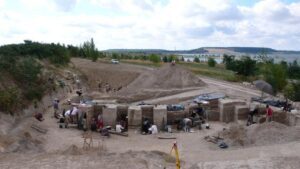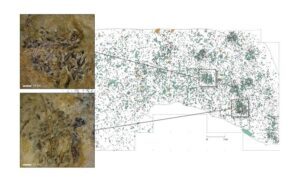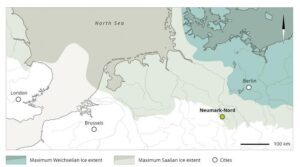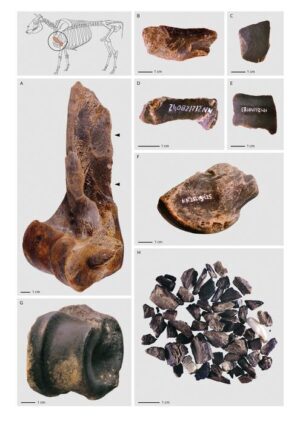
American Association for the Advancement of Science (AAAS)—Neanderthals were rendering animal bones for grease – extracting more nutrients from carcasses – in present-day Germany roughly 125,000 years ago, research suggests. The discovery of a Neanderthal “fat factory” at an Interglacial Paleolithic site substantially pushes back estimates for when hominins began practicing this type of resource intensification. The ability to get extra calories by harvesting bone marrow and grease has played a critical role in humanity’s evolution; better diets helped humans live longer and reproduce more. Until now, most signs of resource intensification have been found at Upper Paleolithic sites around 28,000 years ago, well after Neanderthals became extinct. Lutz Kindler and colleagues reveal that Neanderthals performed resource intensification far earlier in the Homo genus’s evolution, as far back as 125,000 years ago. They analyzed remains from 172 large animals (horses, deer, and bovids) at the Neumark-Nord (NN2/2B) site in present-day Germany. The data*, alongside more than 16,500 flint artifacts, stone manuports, and other items indicating fire use, showed that Neanderthals transported the animals to this 50-square-meter area to fracture bones for rendering into grease. “The evidence from NN2/2B constitutes the earliest clear case of intensive grease-rendering yet documented for the Paleolithic,” Kindler et al. write. The find showcases “a substantial investment by the site’s occupants of both time and effort aimed at retrieving precious lipids from a large number of prey animals,” they conclude.
____________________________

Year -round excavations. The Neumark-Nord 2/2B site was excavated through year-round campaigns by a core team from 2004 to 2009, alongside an international field school that included more than 175 students in total. Roebroeks, Leiden Univ
____________________________

Massive bone processing. At the Neumark-Nord 2 site, near the margin of a shallow pool, there is a dense concentration of bones from more than 170 larger mammals (highlighted in blue), mixed with flint artifacts (red) and hammer stones (red). All bones larger than 3 cm were carefully recorded during excavation and plotted together, creating the impression of a “bone floor” produced by Neanderthal activity at the site. Many of the bones were found in rounded depressions at the base of the excavation layer, as shown in the insets. These depressions represent the final stage of excavation, when most of the bones had already been removed, leaving only the remaining bone fragments at the bottom. Kindler, LEIZA-Monrepos
____________________________

Location of Neumark-Nord (Germany). The site’s position is depicted relative to the maximum extent of the Saalian and Weichselian glaciations. Kindler et al., Sci. Adv. 11, eadv1257
____________________________

From complete bones to tiny fragments. At the Neumark-Nord 2/2B sites, imported bones were initially smashed open to extract marrow from the hollow cavities (see A; arrows indicate hammerstone impacts on an aurochs humerus). Afterward, the bones were crushed and chopped into smaller pieces (shown in B to F, again from a humerus as seen in A) to facilitate the extraction of grease from both the spongy and compact bone tissue. Approximately 2,000 tiny bone fragments accidentally came into contact with fire after boiling, resulting in typical coloration (ranging from dark brown and black to white) and texture commonly found in heated bones. Kindler, LEIZA-Monrepos
____________________________
Article Source: AAAS news release.
*Large-scale Processing of Within-Bone Nutrients by Neanderthals, 125,000 years ago, Science Advances, 2-Jul-2025. www.science.org/doi/10.1126/sciadv.adv1257




